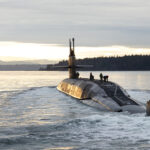
With delays piling up for its two planned plutonium pit factories, the National Nuclear Security Administration (NNSA) already believes it will have to exceed the military’s minimum annual order for the nuclear weapon cores, the head of the agency said Tuesday. “We anticipate that due to all the different things going on that we actually will have years that we can already see where we’ll need more than” the minimum of 80 pits annually that federal law and the military…

 By
By 










